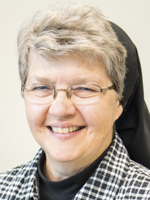
Anyone who has toured or lived in New York City will recall its bulky bronze sculpture of Atlas holding up the world. It occupies the gateway to Rockefeller Center on Fifth Avenue, on the other side of the street from St. Patrick’s Cathedral.
New York has its monument to mythology, but we in the Diocese of Charleston can lay claim to not one but more than a score of Atlases, each one of them really, truly bearing the burden of our weighty planet.
Decades back, Thomas Merton, also known as Father Louis, explained who these other Atlases are. Merton was an acclaimed Kentucky Trappist whose autobiography and spiritual writings captivated readers immediately after World War II and into the Vietnam War era. He observed that it just might be possible that the prayers of those who commit themselves to a largely silent contemplative life are the reason why our world has not been wholly obliterated in a human-engineered holocaust.
The sturdy, simple lives of monks and nuns who begin their prayers as early as 3 a.m. and end at 8 p.m. each day might, Merton suggested, be the hidden axis God uses to spin the earth. Their consecrated lives are about the Lord’s saving work in a heroic, though unsung, way. They intercede for everyone on the face of the earth and for all the special intentions sent their way.
Outside Moncks Corner and Cordesville, we have Mepkin Abbey. Just above Greenville, in Travelers Rest, we have the Monastery of St. Clare. Trappist brothers and priests and the Poor Clares, Franciscan nuns, inhabit these monasteries. Apart from rare outings for an occasion called by the bishop or a ministerial conference, these men and women live secluded lives. They dress in simple habits, eat healthful meals, and spend hours in communal and personal prayer. They offer hospitality to retreatants and visitors and support themselves by working a portion of each day at tasks like mushroom raising, farm tending, baking, craft work, preparing altar breads, and offering spiritual direction.
The Trappists live on a splendid property endowed by Clare Boothe Luce and supported by other donors. Live oak trees, azaleas and camellias, and wooden carvings of the Flight into Egypt and Jesus’ Nailing to the Cross are part of their public gardens. The Poor Clares live in the Piedmont, the chillier part of the state, which has snow in March and rises to the Blue Ridge. Their land borders the Bunched Arrowhead Heritage Preserve with its public hiking trail. The lives of both groups are characterized by simple elegance, reverence for life, and harmony with their natural surroundings. They do deep inner work in spare chapels, uncluttered cells (what they call their bedrooms), and open spaces.
When we think of them, visit their sacred refuges, and meet them, we must remember that, though they carry it lightly, the weight of the world is on their shoulders.
Sister Pamela Smith, SSCM, is the Secretary for Education and Faith Formation at the Diocese of Charleston. Email her at psmith@catholic-doc.org.



